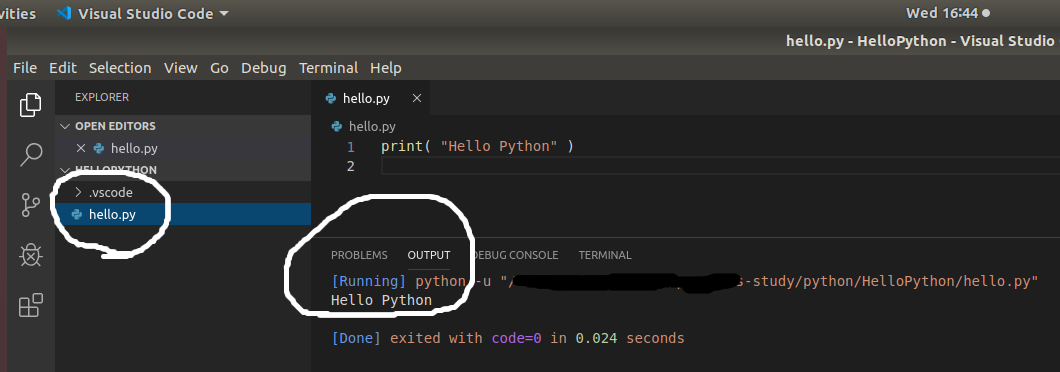- How To Run Python On Visual Studio Code On Mac
- Run Python Tests In Visual Studio Code
- Cannot Run Python Visual Studio Code
- Run Python Script Vs Code
How To Run Python On Visual Studio Code On Mac
-->Installing and Configuring Visual Studio Code for Python Development. Installing Visual Studio Code is very accessible on any platform. Full instructions for Windows, Mac, and Linux are available, and the editor is updated monthly with new features and bug fixes. You can find everything at the Visual Studio Code website. In case you were wondering, Visual Studio Code (or VS Code for short.
Previous step: Create a new Python project
Although Solution Explorer is where you manage project files, the editor window is typically where you work with the contents of files, like source code. The editor is contextually aware of the type of file you're editing, including the programming language (based on the file extension), and offers features appropriate to that language such as syntax coloring and auto-completion using IntelliSense.
Run the code you've written to this point by pressing Ctrl + F5 or selecting Debug Start without Debugging menu item. Visual Studio warns you if you still have errors in your code. When you run the program, a console window appears displaying the results, just as if you'd run a Python interpreter with PythonApplication1.py from the command line. There isn’t much support for Python in Microsoft new code editor Visual Studio Code (VSCode), but there is a neat way to run your Python code right inside VSCode. It’s a feature called tasks and while the examples give are for compiling code, you can pretty much just run any program against the code you are editing in VSCode. I am writing a small application with Visual Studio Code and Python. My application have these files: Main.py MyCustomClass.py Basically, the Main.py is the entry point to the application. The other class is just logic to solve some problems. While I developing the code, I test it, by running it, step by step. Start Python interactive mode to run Python code one line at a time. Install Visual Studio Code, Python, and the Python extension for Visual Studio Code on your computer. Create a Python script file and write Python code in Visual Studio Code. Run your Python script file.
Run Python Tests In Visual Studio Code
After creating a new 'Python Application' project, a default empty file named PythonApplication1.py is open in the Visual Studio editor.
In the editor, start typing
print('Hello, Visual Studio')and notice how Visual Studio IntelliSense displays auto-completion options along the way. The outlined option in the drop-down list is the default completion that's used when you press the Tab key. Completions are most helpful when longer statements or identifiers are involved.IntelliSense shows different information depending on the statement you're using, the function you're calling, and so forth. With the
printfunction, typing(afterprintto indicate a function call displays full usage information for that function. The IntelliSense pop up also shows the current argument in boldface (value as shown here):Complete the statement so it matches the following:
Notice the syntax coloration that differentiates the statement
printfrom the argument'Hello Visual Studio'. Also, temporarily delete the last'on the string and notice how Visual Studio shows a red underline for code that contains syntax errors. Then replace the'to correct the code.Tip
Because one's development environment is a very personal matter, Visual Studio gives you complete control over Visual Studio's appearance and behavior. Select the Tools > Options menu command and explore the settings under the Environment and Text Editor tabs. By default you see only a limited number of options; to see every option for every programming language, select Show all settings at the bottom of the dialog box.
Run the code you've written to this point by pressing Ctrl+F5 or selecting Debug > Start without Debugging menu item. Visual Studio warns you if you still have errors in your code.
When you run the program, a console window appears displaying the results, just as if you'd run a Python interpreter with PythonApplication1.py from the command line. Press a key to close the window and return to the Visual Studio editor.
In addition to completions for statements and functions, IntelliSense provide completions for Python
importandfromstatements. These completions help you easily discover what modules are available in your environment and the members of those modules. In the editor, delete theprintline and start typingimport. A list of modules appears when you type the space:Complete the line by typing or selecting
sys.On the next line, type
fromto again see a list of modules:Select or type
math, then continue typing with a space andimport, which displays the module members:Goldvision sound cards & media devices driver download for windows. Finish by importing the
sin,cos, andradiansmembers, noticing the auto-completions available for each. When you're done, your code should appear as follows:Tip
Completions work with substrings as you type, matching parts of words, letters at the beginning of words, and even skipped characters. See Edit code - Completions for details.
Add a little more code to print the cosine values for 360 degrees:
Run the program again with Ctrl+F5 or Debug > Start without Debugging. Close the output window when you're done.

Next step

Cannot Run Python Visual Studio Code

Run Python Script Vs Code
Go deeper

